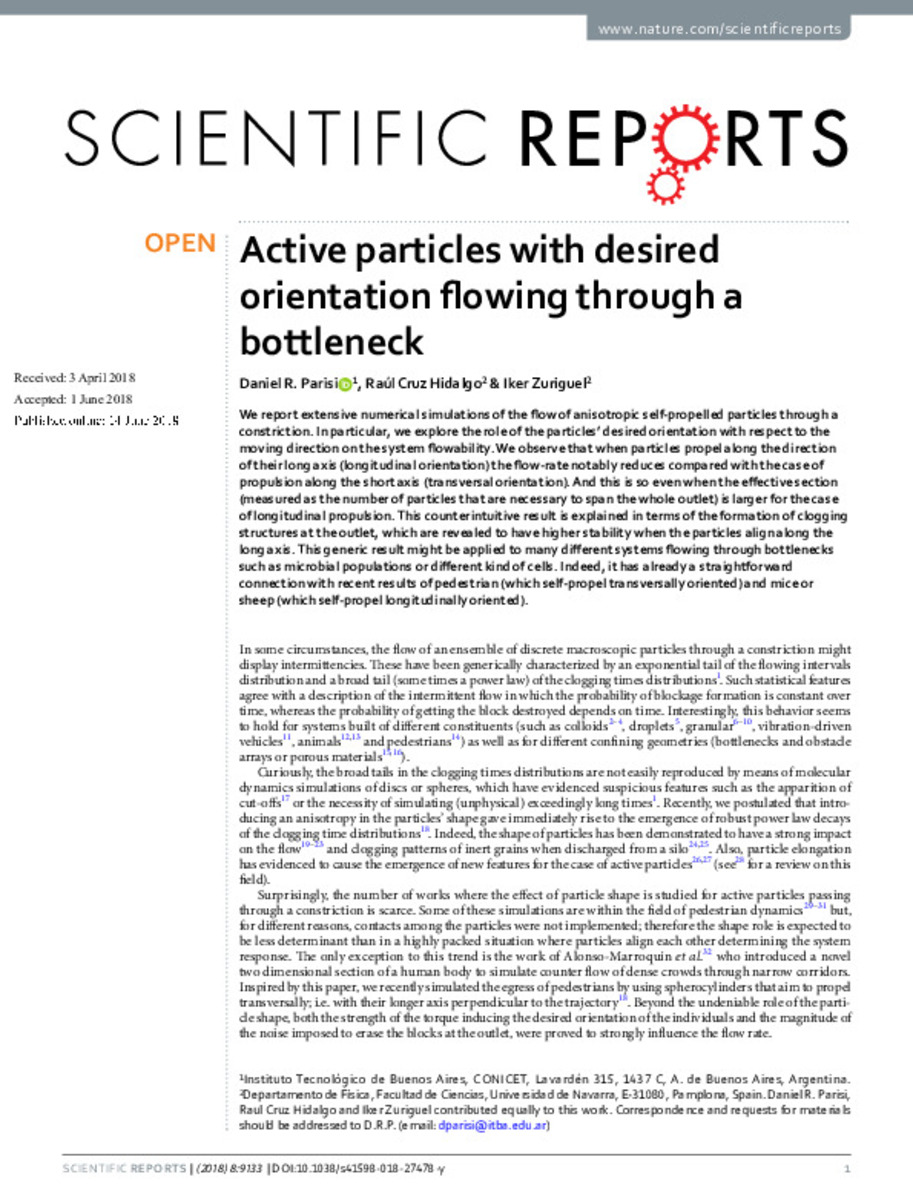Registro completo de metadatos
| Campo DC | Valor | Lengua/Idioma |
|---|---|---|
| dc.creator | Parisi, D.R. (D. R.) | - |
| dc.creator | Cruz-Hidalgo, R. (Raúl) | - |
| dc.creator | Zuriguel-Ballaz, I. (Iker) | - |
| dc.date.accessioned | 2022-10-19T10:37:48Z | - |
| dc.date.available | 2022-10-19T10:37:48Z | - |
| dc.date.issued | 2018 | - |
| dc.identifier.citation | Parisi, D.R. (D. R.); Cruz-Hidalgo, R. (Raúl); Zuriguel-Ballaz, I. (Iker). "Active particles with desired orientation fowing through a bottleneck". SCIENTIFIC REPORTS. 8 (1), 2018, 9133 | es_ES |
| dc.identifier.issn | 2045-2322 | - |
| dc.identifier.uri | https://hdl.handle.net/10171/64516 | - |
| dc.description.abstract | We report extensive numerical simulations of the fow of anisotropic self-propelled particles through a constriction. In particular, we explore the role of the particles’ desired orientation with respect to the moving direction on the system fowability. We observe that when particles propel along the direction of their long axis (longitudinal orientation) the fow-rate notably reduces compared with the case of propulsion along the short axis (transversal orientation). And this is so even when the efective section (measured as the number of particles that are necessary to span the whole outlet) is larger for the case of longitudinal propulsion. This counterintuitive result is explained in terms of the formation of clogging structures at the outlet, which are revealed to have higher stability when the particles align along the long axis. This generic result might be applied to many diferent systems fowing through bottlenecks such as microbial populations or diferent kind of cells. Indeed, it has already a straightforward connection with recent results of pedestrian (which self-propel transversally oriented) and mice or sheep (which self-propel longitudinally oriented). | es_ES |
| dc.description.sponsorship | Tis work was funded by Ministerio de Economía y Competitividad (Spanish Government) through FIS2014– 57325 and FIS2017-84631 MINECO/AEI/FEDER, UE Projects; and PID 2015-0003 (Agencia Nacional de Promoción Científca y Tecnológica, Argentina; Instituto Tecnológico de Buenos Aires; Urbix Technologies S.A.). | es_ES |
| dc.language.iso | eng | es_ES |
| dc.publisher | NCBI | es_ES |
| dc.rights | info:eu-repo/semantics/openAccess | es_ES |
| dc.subject | Anisotropic | es_ES |
| dc.subject | Longitudinal orientation | es_ES |
| dc.title | Active particles with desired orientation fowing through a bottleneck | es_ES |
| dc.type | info:eu-repo/semantics/article | es_ES |
| dc.description.note | This article is licensed under a Creative Commons Attribution 4.0 International License, which permits use, sharing, adaptation, distribution and reproduction in any medium or format, as long as you give appropriate credit to the original author(s) and the source, provide a link to the Creative Commons license, and indicate if changes were made. Te images or other third party material in this article are included in the article’s Creative Commons license, unless indicated otherwise in a credit line to the material. If material is not included in the article’s Creative Commons license and your intended use is not permitted by statutory regulation or exceeds the permitted use, you will need to obtain permission directly from the copyright holder. | es_ES |
| dc.identifier.doi | 10.1038/s41598-018-27478-y | - |
| dadun.citation.number | 1 | es_ES |
| dadun.citation.publicationName | SCIENTIFIC REPORTS | es_ES |
| dadun.citation.startingPage | 9133 | es_ES |
| dadun.citation.volume | 8 | es_ES |
Ficheros en este ítem:
Estadísticas e impacto
Los ítems de Dadun están protegidos por copyright, con todos los derechos reservados, a menos que se indique lo contrario.






